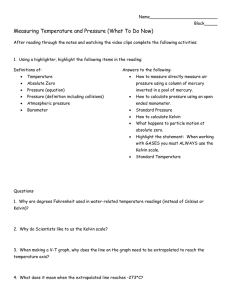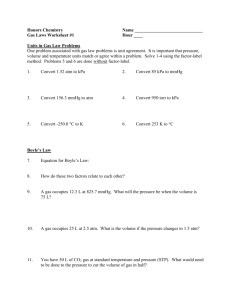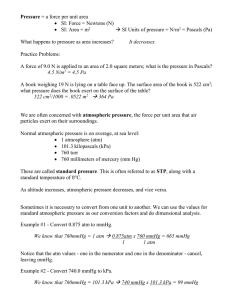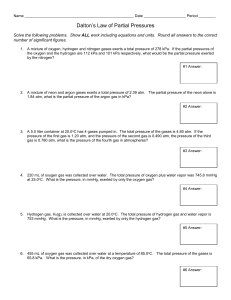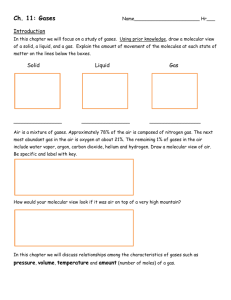10.1 notes - TeacherWeb
advertisement
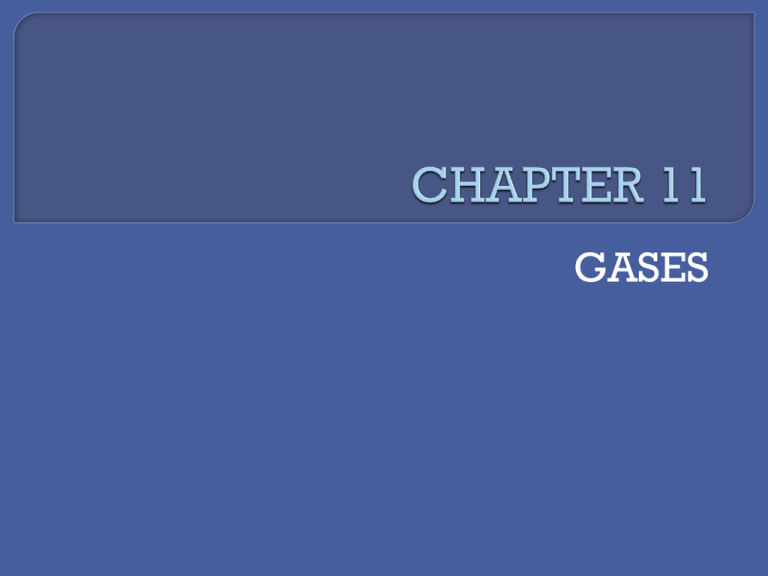
GASES GASES AND PRESSURE Why are gases so unique? Gases are unique because their physical properties are determined by the pressure, volume, temperature, and the amount of gas present. What is pressure? Pressure = Force / Area Pressure = Force / Area If the force increases, how does it affect the pressure? Who exerts more pressure? Why? Pressure = Force / Area As the force increases, the pressure increases. Pressure = Force / Area How does area affect pressure? Assume the same person is wearing these, which of these exerts more pressure? Why? Pressure = Force / Area As the area decreases, the pressure increases. Pressure = Force / Area The newton, N, is the SI unit for force. How strong is the atmospheric pressure? Atmospheric pressure is formed by all the gas particles being pulled toward the Earth. What gases make up the atmosphere? Atmospheric pressure is formed by all the gas particles being pulled toward the Earth. Atmosphere = 78% N2 21% O2 1% (Ar, CO2, H2O, etc.) How does atmospheric pressure vary with altitude? What instrument is used to measure pressure? A barometer measures atmospheric pressure. These can also be used to measure atmospheric pressure. A barometer measures atmospheric pressure. Mercury was/is used because its volume changes very little with changing temperature. A barometer measures atmospheric pressure. A manometer can be used to measure gases in a container. It can be an open or a closed manometer. This is an open manometer. These are all closed manometers. These are open manometers at room temperature and standard pressure (101.3 kPa). 1. Which one contains a gas at 90 kPa? 2. Which manometer has the lowest pressure? 3. In which one is the pressure the greatest? 4. Which manometer could have a leak? What are the units of pressure? Pressure units: The units we will use are the following: Atmosphere (atm) Millimeters of mercury (mm Hg) Kilopascals or pascals (kPa, Pa) Torr Pressure units: The units we will use are the following: Atmosphere (atm) Millimeters of mercury (mm Hg) Kilopascals or pascals (kPa, Pa) Torr The units commonly used in the US are the following: Inches of mercury Millibars Pounds/in2 p. 364 Pressure units: STP = Standard temperature and pressure 1 atm and 0ºC (273 Kelvin) Pressure units: 1 atm = 760 mmHg = 101.3 kPa = 760 torr Example 1: Convert 745 mmHg to atm and kPa. Example 2: Convert 88.86 kPa to atm and mmHg. Gas Laws are used to predict the pressure, volume, or amount of gas in a container when the conditions change. Dalton’s Law of Partial Pressure Dalton’s Law of Partial Pressure When gases are mixed, the total pressure is calculated by adding up the pressures of all the gases in the mixture. Ptotal = P1 + P2 + P3 . . . Dalton’s Law of Partial Pressure The mole fraction of the gases can also be determined by using the pressure of each gas. Example 3: What is the atmospheric pressure if the partial pressures of nitrogen, oxygen, and argon are 604.5 mmHg, 162.8 mmHg, and 0.5 mmHg, respectively? If a gas is collected over water (as we will do in lab), there is a small amount of water vapor present. This has to be taken into consideration when calculating the total pressure above the water. Example 4: A student generates O2 in a set up similar to p. 366. The gas is collected at 25ºC and the level of water inside and outside the collection jar is equal. If the atmospheric pressure is 758 mmHg, what is the pressure of just the O2? (H2O vapor pressure at 25ºC is 23.8 mmHg) Example 5: A tank contains 5 moles of O2, 6 moles of H2S, and 4 moles of Ar at a total pressure of 1620 mmHg. What is the pressure of each gas?
